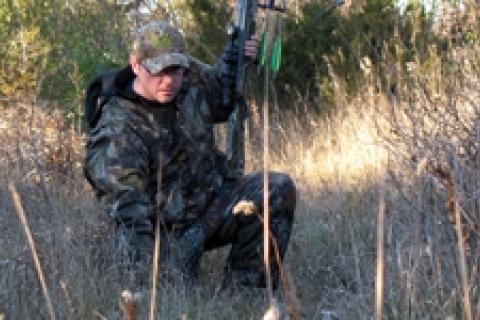
|
|
| Be sure to wait at least 30 minutes before you set out to track your game. Photo courtesy of Luigi De Rose |
As deer hunters, we strive for quick, one-shot kills. Unfortunately things sometimes just don't work out that way, and an animal runs off after the shot. Here are some tips to help you recover your animal. Although I will use deer as a reference in this two-part blog, these tips really apply to any big game animal.
- Make the first shot count. Some of the most important things you can do to minimize the amount of tracking should actually be done before you take the shot. Make sure you've chosen an appropriate cartridge-bullet combination, and carefully pick your shot. This means waiting for a good broadside or quartering-away shot, and passing on others. It also means not shooting when the target is beyond your maximum comfortable range or if there are obstructions that may deflect a bullet. This level of discipline is hard to achieve, especially when the target is a trophy buck and you have few such opportunities, but nothing can ruin a season like a lost trophy or an animal that suffers needlessly. To help ensure clear shots, carefully choose the location of your tree stand or ground blind. This requires pre-season scouting, factoring in the prevailing wind direction, morning and evening sun locations, surrounding terrain, available cover, etc.
- Refine your shooting. The second item of pre-shot importance is practice. Getting a good shooting opportunity is one thing, but you must be able to hit the mark. Using the same equipment you plan to hunt with; practice until you are completely familiar with all of your gear; and you are comfortable shooting at longer ranges, from a variety of positions. If possible, also practice shooting from your tree stand or ground blind.
- Know the distance. Knowing the distance to your target is crucial. Practicing naked-eye range estimation in case of sudden, unexpected shooting opportunities is wise, but the best method is to use a laser rangefinder, as they are highly accurate, light, compact and affordable. Try to range a few key objects in all directions around your stand before game appears.
- Stay focused. Let's say you've taken the shot, but the buck has run off and disappeared. It is extremely important that you make a careful mental note of where the animal was standing when you fired and where you last saw it before it vanished. The latter is where you will start tracking, while the shot site should offer clues as to whether you actually hit the animal. I can't over-emphasize the necessity to indelibly mark these two spots in your mind, in preparation for the next step.
- Take your time. You've made a mental note of where you last saw the deer. Now wait for at least 30 minutes. Sit back and relax, but don't forget the location of the above two sites. It's very difficult to resist the temptation to charge off after your trophy, as you imagine it getting further away with each passing minute, but resist you must. Don't even climb down from your tree stand, as the animal may see, hear or smell you. The reason for the long wait is simple. If you immediately start stomping around after the deer, you will push it further away, as adrenaline will start pumping through the deer's system and may allow a mortally wounded animal to travel much farther than one that is left alone, thereby making tracking and recovery that much harder (especially if you suspect you made a poor shot or hear the animal still on its feet). If not pursued, the animal will likely lie down to rest after a short distance and will then succumb. With a solid hit in the vitals, it will usually not travel more than 100 yards, unless harassed. A good way to occupy your mind while waiting is to reflect on the shot. Did you see or hear the bullet strike? How did the animal react to the shot? A deer that runs off with its head and neck stretched out low to the ground crashing through the brush is a good indicator of a hit, as is a deer that kicks out its hind legs as it runs off. However, the absence of such signs does not automatically mean a miss.
While this 30-minute rule is critical, there are times when it is simply not possible or practical. If heavy rain or snow is falling, and would quickly obliterate all sign, immediate tracking, preferably with some assistance, is usually advisable. Rapidly approaching nightfall can be another exception. In areas with high predator populations, namely coyotes, anything left out overnight may be ruined or eaten by morning, so immediate or night time follow-up may be necessary. Otherwise, postponing the search until morning is usually a good idea, especially when the temperature is cool enough to prevent spoilage of the meat. You must simply use your judgment under such circumstances.
In part 2, we'll talk about the mechanics of tracking.
Good hunting.
- 2898 views

